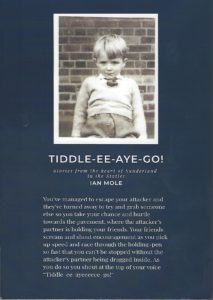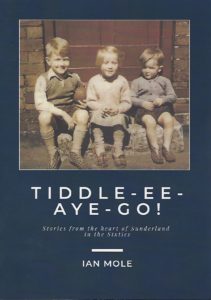
Mike Dennison, well known to subscribers to the Black Cats e-mail loop, alerts us to a fascinating book of Sunderland reminiscences from the prolific Ian Mole …
Many Sunderland fans will be familiar with Ian Mole’s writing from the informative and amusing Lines From London Reports he has contributed to the website of the fanzine A Love Supreme.
I am always surprised at how he can produce an entertaining piece on a match to which his only access is radio via the internet.
Ian has now written a book of stories – Tiddle-ee-aye-go! Stories from the Heart of Sunderland in the Sixties – about his childhood in the 1950s and 60s, growing up in Elmwood Street and Otto Terrace or as Ian puts it “South Central. Not LA but Sunderland”.
This is a wee gem of a book comprising 47 stories from a childhood spent growing up in this bit of the town.
They include pieces about his family and pets, street games, memories of Chester Road School, playing footy, going to Roker Park, the Saturday morning pictures, going to see the Beatles at the Empire, train spotting, hobbies, local shops, sweets and going to the doctor.

In short, it is a valuable piece of social history about a very specific time and place. one that has changed dramatically in the intervening years. For the SAFC fans out there, stories that might be of particular interest include: –
- Memories of the Early Sixties at Roker Park
- The Night Nicky Sharkey Made Me Sleepwalk
- Autograph Hunting
- The Man United Match
I should stress that this is a collection of self-contained stories not chapters in a novel, so there is some repetition of the same incidents and events between stories; readers may want to dip in and out rather read the entire book serially.
The good point is while Ian is looking back in time, this is no rose-tinted nostalgia fest. Rather he is simply remembering events from his early years and turning them into stories that will entertain any reader and describe for younger people how life used to be 50-odd years ago. Ian has an amazing memory and these stories reflect that.
I have an interest to declare. Ian is an old mate and I’ve known him nearly all my life. However, even if we’d never met, I would have enjoyed this book simply because he writes so well. And I can certainly attest to the accuracy of some of the stories.
As suggested by the sub-title, Stories from the Heart of Sunderland in the Sixties, the town – as it was then – is really one of the central characters of the book.
Allow me to provide a little social and geographical background. There’s no definition of “South Central Sunderland” that I’ve ever heard, but you could roughly define it as comprising Thornhill, the Durham Road as far as the Barnes, Chester Road and Hylton Road, Millfield and perhaps Pallion.
Kids of the time might have defined it by Parks – Barnes Park (but not the extension), Burn Park, the farmland now occupied by Thornhill School, Backhouse Park and Mowbray Park including the often lamented “Swingy Park” where the Civic Centre now broods.
In the days before many of the town’s housing estates had been built, this was where a large number of Sunderland’s families lived – mainly in private rented accommodation – often with three or more generations in the same house.
The streets off Chester Road and Hylton Road tended to be rows of two up/two down back-to-backs, while there were larger Victorian and Edwardian houses on the other side of the Durham Road.
Back yards were ubiquitous and outside lavvies often the only toilet. There was a very definite sense of local community; teachers in particular and adults in general were feared if not respected.
The student population of the town was tiny compared to now and bedsits and student flats were very much the exception rather than the rule.
In the late 50s the Second World War was a very recent memory for adults and Sunderland bore many of the scars of those years.
Few people had TVs, fridges or phones until the 60s, most people shopped locally on a daily basis and went “down the town” for any major purchases. Hardly anyone had a car and kids played out on the streets – often from the age of four or five.
An efficient bush telegraph – comprised mainly of Nanas behind twitching net curtains – was in operation and news of any misdemeanours committed out in the street often reached home before the unfortunate child.
By the mid-60s huge numbers of families had moved out of this area into the new council estates and the demographics and the nature of the area had started to change.
For those of you not familiar with this bit of Sunderland, Elmwood Street is just off the one-way southbound section of the A690 Durham Road where it goes past Burn Park about 100 yards on from the site of the old Royal Infirmary.
Back in the day this was a rather pretty tree-lined avenue called Burn Park Road and was a very quiet residential street. The Durham Road was a two-way avenue on the other side of Burn Park. Otto Terrace is just a stone’s throw away and used to join the Durham Road on the junction with Eden House Road, although these days it is no longer meets the A690 as this junction was just too dangerous.
Ian published the book himself and it is available either directly from him via Facebook or on eBay at the following URL – https://www.ebay.co.uk/itm/Stories-From-The-Heart-Of-Sunderland-In-The-Sixties-by-Ian-Mole/253418408883?hash=item3b00ea0bb3:g:cLkAAOSw5utafabB. It costs £12.50 including postage and Ian has only had 100 copies printed so you might need to move quickly if you want a copy.

I attended Chester Road School throughout the1960s and have read many of Ian’s FaceBook posts. His memory is fantastic and his posts have triggered considerable conversations.
I have ordered my book and look forward to reading more stories of my early childhood.
Good luck Ian.
Ian and I worked together briefly with young offenders in Sunderland in 1977. Does he remember The Murton Stare I wonder?